Hold My Hand
A brief history of reading my friends’ palms
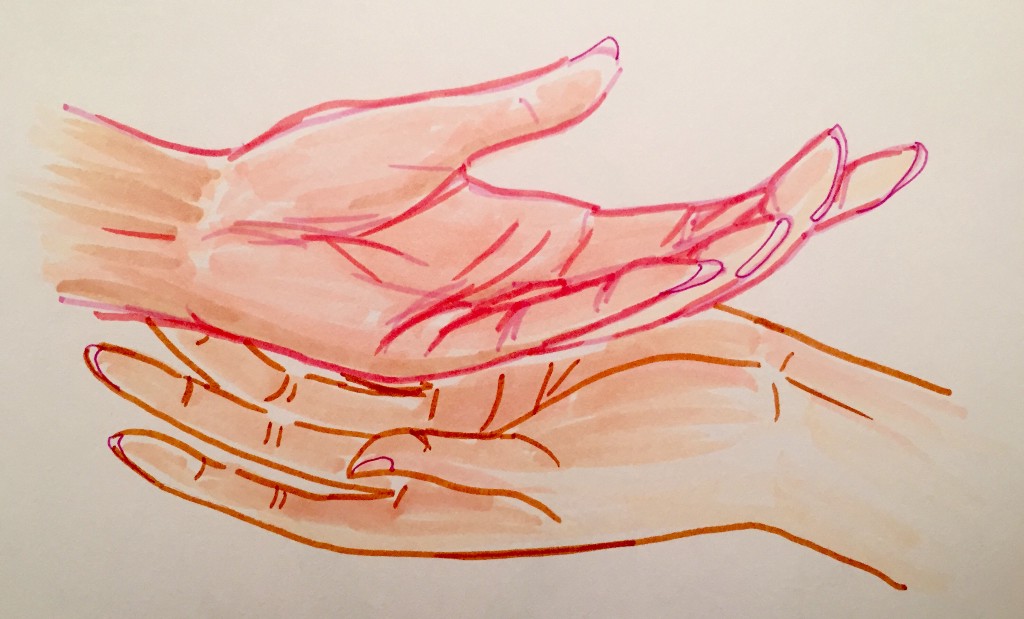
My college roommate and I are up late when I tell her that I knew how to read palms. This late at night heart to heart is the usual for us, but clearly my comment strikes a chord.
“Really?” she says.
I blink at her hopeful tone. With her a transfer student and me about to graduate, we’d been commiserating on our anxiety about the future. The palm-reading was just something I’d said to lighten the mood.
I hesitate, unsure if we’re playing a game; if I’m pretending, or she’s pretending, or if we’re both in on the joke. But when she opens her palm and holds it out to me, there’s only one thing to do. I read it.

When I read palms, I follow my own makeshift routine, based on a few precepts of fortune-telling and palm-reading I’d found in stories and books. I improve as I gain experience, tweaking what work, purging what doesn’t.
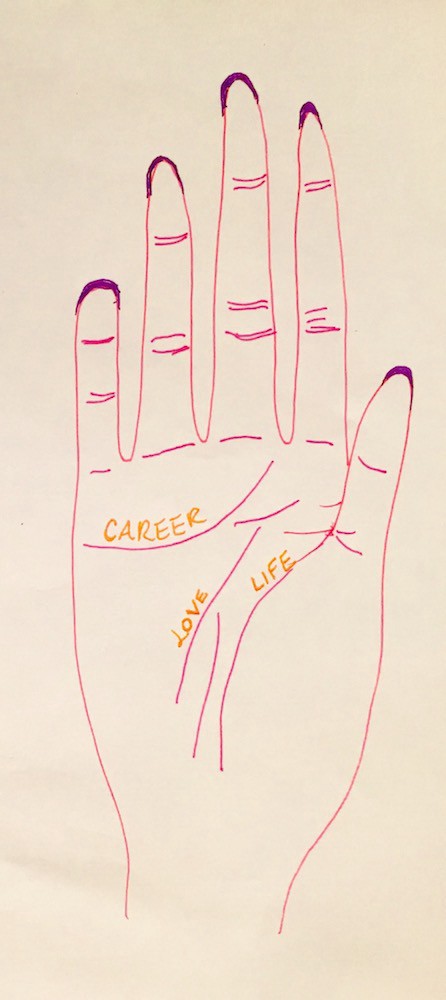
I worked mostly on intuition, however, which makes sense — I was practicing an ancient art. But it’s ancient ancient. I was surprised to find out that reading palms, or “palmistry” allegedly originated from Hinduism, and Ancient India, before spreading all over the world, according to the Encyclopedia Britannica. (Check that “occultism” label EB slapped on it!) But I suppose that makes sense — before we had the technology to check whether Mercury was in retrograde, or tea leaves to read, we had our hands, and the particular lines on them.
“This is your career line, your love line, and your life line,” I would say, touching each of them gently, recalling blurry images from a book I read in high school.
The lines are simple: they follow the rising and falling action of a novel. “The way this line is made up of little lines,” I might add, “means that a lot of different factors will soon be at play.”
I always tell a happy tale. I had taken to heart the moral of an Indian story I read when I was little: A fortune-teller comes to the Emperor’s vizier, Birbal, and asks for advice on a reneged payment. He says, “I told this man his whole family would die before he did, and he refused to pay.” Birbal tells him he should always spin his stories with optimism. So the fortune-teller disguises himself and goes back to his client. He tells him, “You will outlive all your relatives.” The client pays him double, pronouncing him “much better” than his previous fortune-teller.
One of my biggest assets, however, is the strength of my voice, the assurance in my tone. When a friend agonizes over a break or faded curve, an indistinct mark, I’d brush it off. “See how later it becomes stronger and clearer?” There’s something to confidence that calms the stormy waters of our minds. I suppose that’s how con men work, how people lose millions of dollars to fortune-tellers and tarot card readings and palm readers: they just sound so sure.

For me, palm-reading goes hand in hand with friendship. In high school it was something I did to make friends — something to distinguish myself as someone worth knowing, back when I myself couldn’t believe I was.
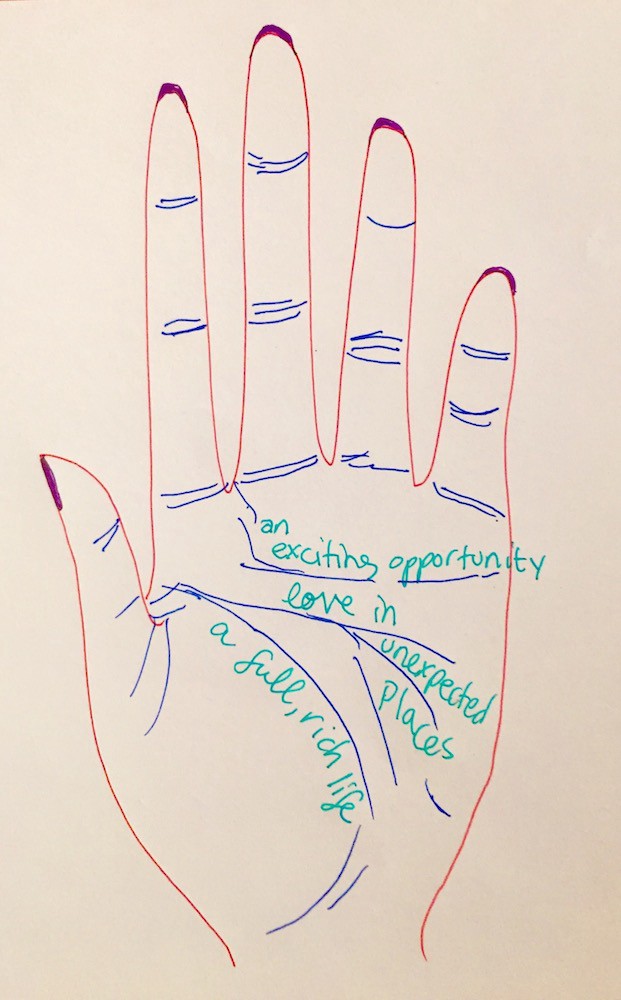
(This reminds me of something my mother told me — that in India, boys would tell girls they could read palms so they could hold the girls’ hands without getting in trouble in more conservative environments.)
By graduate school, I’d honed my skills (and PR) well; I found myself surrounded at the holiday party, my voice going hoarse as my classmates lined up in front of me.
It’s striking, how intimate a palm-reading can be, when it’s both the friend and the future you’re invested in. You’re looking at their face as much as you’re looking at their palm; sometimes an imploring look or bright smile will tell you more about their friend’s future more than a specific contour.
I read the palms of one of my roommates and her date. Their reactions were very different: she was thoughtful, even dismissive — I’d read her palm before and she lived with me; she knew I was blundering through it all as much as she was. But her date, a stranger to me, was alarmed, inspired, making connections to old projects and new ideas.
One time, while waiting in line with a friend at that Cupcake ATM in Beverly Hills, I was reading a friend’s palm and the woman behind us asked a turn.
“Yes, finally!” she exclaimed, when I said her career line spoke of good fortune. “I’m so ready for a job!”

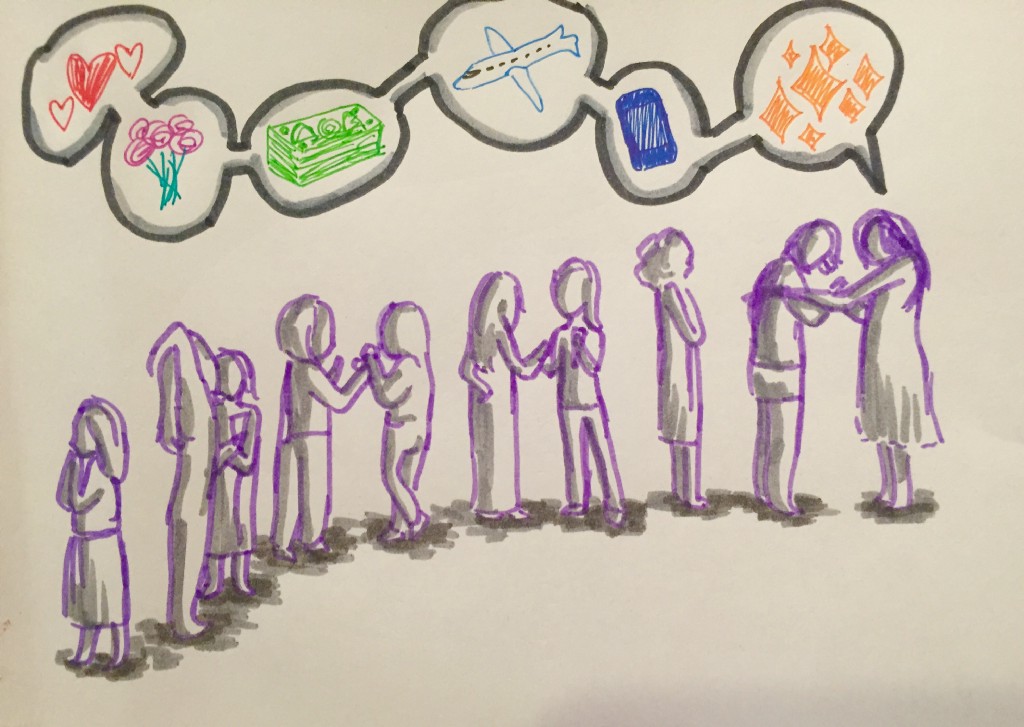
When you’re young, the future feels so unknowable. A friend told me about graduating from college in the early 2000s and it sounded some kind of long-ago utopia: you’d graduate, apply, get a job, get on with it. Compare that to friends who graduated in 2008 — a horrifying, twisted dystopia in comparison. For those who graduated in the 2010s, it seemed like the only way to get a good job was to be completely confident, an expert in your field — next to impossible when you’ve just graduated.
n+1 had a piece on this not long ago, exploring the attraction of astrology in uncertain times:
“When had astrology become our irrationality of choice? Probably sometime around 2012, when things were not so good for us. When you’re feeling stuck, one way to convince yourself change is in the near to middle distance is to read a horoscope. It didn’t matter that the mechanism by which it worked was dubious….Our horoscope, at least, gave us something to look forward to.”
Similarly, when I began freelancing a couple of years ago, I became obsessed with horoscopes instead. Forget far-flung futures — I needed to know the shape of the next month, its curves and peaks and falls. I recognized the same tricks I used in palm-reading in these horoscopes: the narrative, the reassurance, the exact dates on which bad things might happen and how to avoid them. I also understood why my old tricks had worked. The horoscopes usually had a compassionate, promising tone — like one you might use to talk to a friend in low spirits.
Reading horoscopes were, for me, more about managing my own tempestuous anxieties in the face of so much uncertainty. The way they reduced time into blocks — the horoscope of the day, week, month, year — helped me reduce those times into narratives with arcs that made sense rather than constant chaos.
I learned to use little tricks to parse my impatience. Watch, I told myself, your feelings will change in an hour. Look, I’d remind myself, how your anxieties will evolve in a week. Wait, I’d promise myself, your life will change in a few months — and if it doesn’t, you can change it yourself.

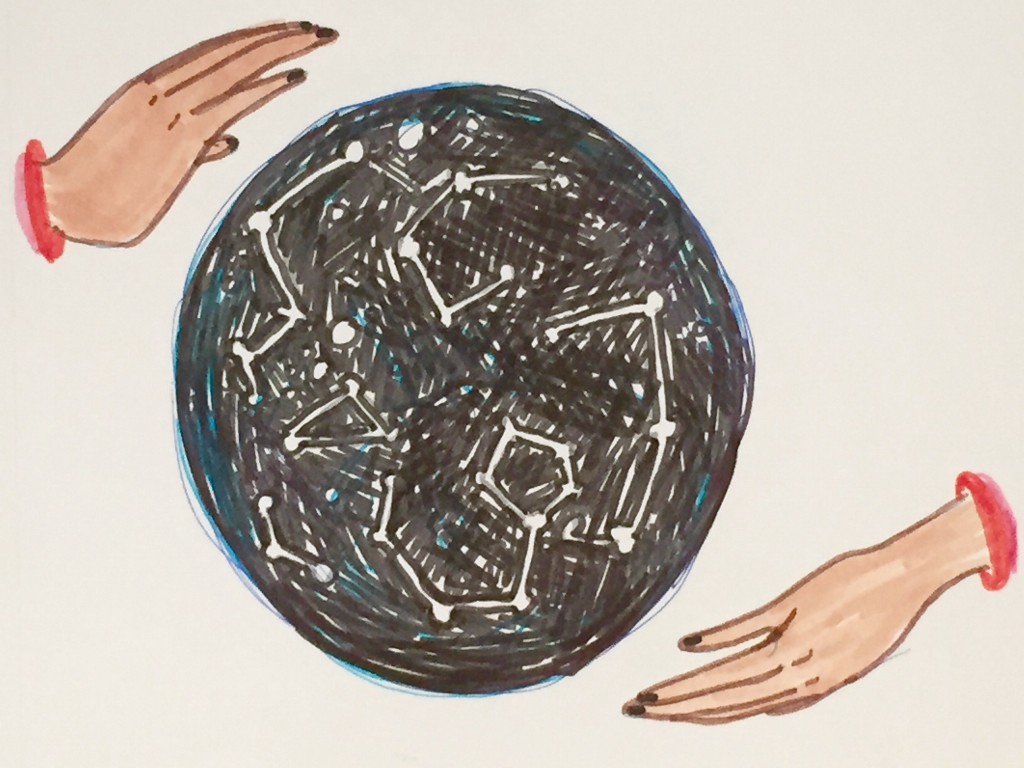
In the months and years following grad school, palm-reading fell to the wayside. Partly because with my friends scattered across the country, their palms were inaccessible. But I was also starting to feel dumb, pretending I knew what the future held — especially when I would struggle to comfort myself on the very subject.
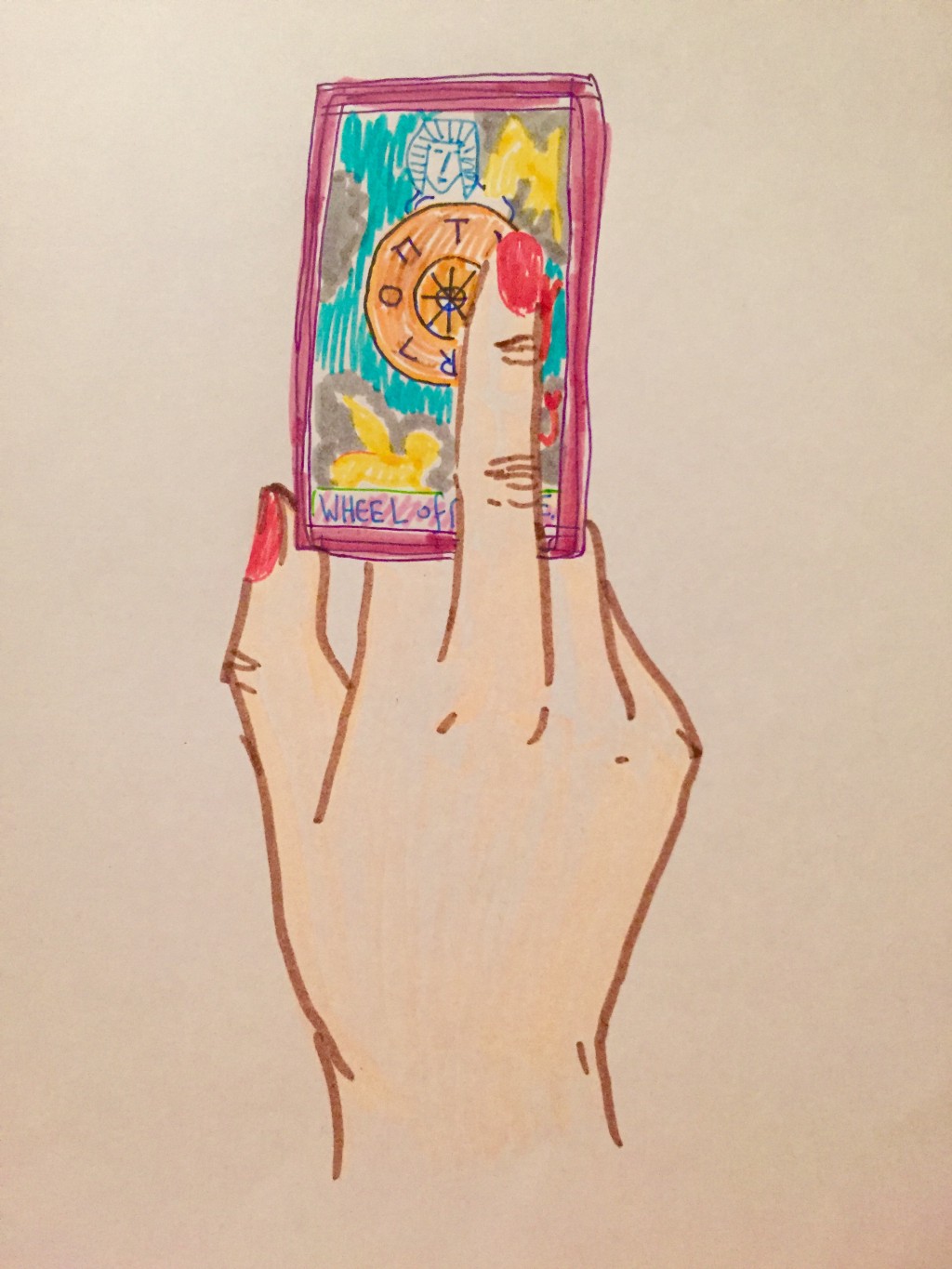
Recently, on a weekend trip to visit those distant friends, another friend asked me to read her palm — something that I’d already done for her a few times. After I did, another friend suggested she do a tarot card reading for me.
Before I knew it, I was on the other side of the table, telling her about my hopes and fears and struggles to understand the future. It was a relief to say them aloud, to admit to being uncertain even though I’d just acted like I knew all the answers. She turned over the cards with finality and direction before looking straight into my eyes with a confidence that I recognized in my own dealings. But I couldn’t help it — I was hooked. I leaned forward and let my insides untangle.